Guest Blogged By Michael Richardson
 Thomas Wilkey, Executive Director of the U.S. Election Assistance Commission (EAC), seems to bear more direct responsibility for the growing voting machine test lab scandal than any other person. Let's connect a few dots and sift through a bit of murky alphabet soup.
Thomas Wilkey, Executive Director of the U.S. Election Assistance Commission (EAC), seems to bear more direct responsibility for the growing voting machine test lab scandal than any other person. Let's connect a few dots and sift through a bit of murky alphabet soup.
For nearly a decade, Wilkey has overseen the testing process of electronic voting machines, keeping recently revealed problems with the so-called “Independent Testing Authorities” (ITA) a secret from public and elections officials alike. Wilkey also tried to prevent federal oversight of the testing process during the development of the Help America Vote Act (HAVA), and worked to keep the National Institute of Standards and Technology (NIST) out of his hidden world.
The EAC inherited the responsibility of qualifying voting machine test laboratories from the National Association of State Election Directors (NASED), where Wilkey strategically positioned himself to control the test laboratories. When HAVA eventually assumed responsibility for the test laboratories from NASED and handed it to the EAC, Wilkey worked behind the scenes to try to keep control over the labs for himself.
Wilkey, formerly the director of the New York State Board of Elections, was appointed to his present position at the helm of the EAC on June 20, 2005. At the time of his appointment, Wilkey chaired the NASED Voting Standards Board, which oversaw the testing labs for voting machine qualification. Wilkey, a founder and past-president of NASED, also chaired the organization’s ITA Committee from 1998 until his departure to the EAC.
As well, Wilkey also served several tours of duty on the board of directors of The Election Center, a non-profit group of dubious (or at least mysterious) background headed by R. Doug Lewis, who is also one of the founders of NASED. The Election Center acted as technical consultants to NASED on voting machine testing. From 1998 until his move to the EAC then, Wilkey was in charge of every aspect of control, selection, and oversight of the voting machine test labs.
His involvement, therefore, in the entire process and the recently revealed failed accreditation of one of the previously-approved labs, CIBER, Inc., deserves close scrutiny --- particularly as one reads Wilkey's bio [PDF] as posted over at the EAC website which describes him as...
"...The perfect candidate to become the first permanent executive director of the U.S. Election Assistance Commission, the new federal entity created by the law he helped craft, the Help America Vote Act of 2002."
When the EAC assumed control of the test labs, a little over a year after Wilkey joined the EAC, a review of the labs was conducted and a secret assessment [PDF] of CIBER led to the EAC's denial of interim accreditation. Suddenly, the nation’s largest voting machine test lab was banned from testing, for sloppy and inadequate work. Yet neither the public nor Elections Officials were alerted to problems at the lab where more than 60% of American voting machines were supposedly tested before their use last November and in the prior months during primary season.
Wilkey decided to keep CIBER’s failures from the public and suppressed the secret assessment until January 2007 after a New York Times expose and pressure from the New York State Board of Elections in the form of a subpoena threat, as The BRAD BLOG reported last week.
Wilkey was in charge when the now-banned test lab, CIBER, Inc., took over from Metamor, Inc., in 2002. Wilkey was in charge when Metamor took over from Nichols Research, which began testing voting machine software for NASED in January 1997 under the auspices of the Election Center. Throughout the Nichols/Metamor/CIBER mergers, Shawn Southworth always conducted the testing in Huntsville, Alabama. Wilkey sought to cement his control over the testing process and had CIBER’s Southworth added as an “ex officio” member of the NASED Voting Standards Board, chaired by Wilkey.
Because of the entangling committees and boards that Wilkey served on or chaired, the only way he can escape full responsibility for the CIBER failures would be to claim he did not know what was going on and that he relied on others. However, the EAC news release announcing Wilkey’s arrival to the federal agency suggests otherwise: “He is respected throughout the nation for his keen understanding of the election process and of the requirements of HAVA.” Further, “Wilkey worked with the Federal Election Commission (FEC) for many years, including serving on its Voting Systems Standards Committee and its Advisory Panel.”
At the time that Congress was debating HAVA and its mandate to create the EAC, the state election officials that comprised NASED were working to keep control of the test labs. Christopher Thomas, then president of NASED, sent out a group email outlining the status of the pending legislation and NASED’s concerns. E-Voting watchdog organization BlackBoxVoting.org obtained a copy of the November 29, 2001 email [PDF] revealing Wilkey’s knowledge of problems with the test labs and his efforts to keep control over them away from federal government oversight and from that of National Institute of Standards and Technology (NIST).
Thomas wrote in his email:
...
Finally, it should be noted that NASED’s Federal Election Recommendations called for the ITA accreditation project to remain with NASED. The legislation does not follow this recommendation. It follows Congressman’s Ehler’s legislation empowering NIST to handle the accreditation of independent test laboratories (ITAs). We seek equal partnership with NIST in the process of accrediting ITAs.
I have come to appreciate the position of NASED members involved in the current ITA accreditation process. They are adamant that there must be election expertise at the table for this process to work properly. Some in Congress have projected this as simply some kind of technocrat type of activity: an ability to read and understand the standards; the essential tools and facilities to test; and the ability to apply the standards to a test plan for voting systems. Sounds like a lot of pocket protectors to me! But time and time again examples are advanced as to the necessity of the elections angle in assessing the ability of a lab to properly function. It is not merely technical expertise. NASED’s ITA Board [chaired by Wilkey] has had problems with ITA management and testing processes. Many of the problems go beyond the four corners of the standards.
Thomas Wilkey’s responsibility for voting machine test laboratories did not begin when he joined the EAC. The failures of the CIBER test lab are also the failures that Wilkey brought with him to his new position.
There will be more as we continue to unravel this mess and peel the stinking onion. Stay tuned...


 Vets Push Back at Trump, Musk Plan to Slash Health Care, 80K V.A. Jobs: 'BradCast' 3/27/25
Vets Push Back at Trump, Musk Plan to Slash Health Care, 80K V.A. Jobs: 'BradCast' 3/27/25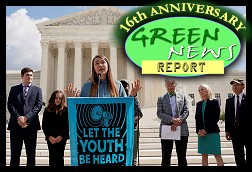 'Green News Report' 3/27/25
'Green News Report' 3/27/25
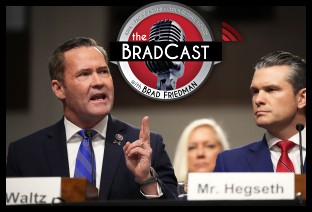 Signal Scandal Worsens for Trump, GOP; Big Election Victories for Dems in PA: 'BradCast' 3/26/25
Signal Scandal Worsens for Trump, GOP; Big Election Victories for Dems in PA: 'BradCast' 3/26/25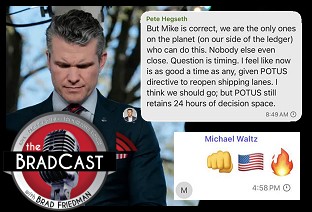 'Emptywheel' on Why Trump NatSec Team Should 'Resign in Disgrace' After Signal Chat Debacle: 'BradCast' 3/25/25
'Emptywheel' on Why Trump NatSec Team Should 'Resign in Disgrace' After Signal Chat Debacle: 'BradCast' 3/25/25 'Green News Report' 3/25/25
'Green News Report' 3/25/25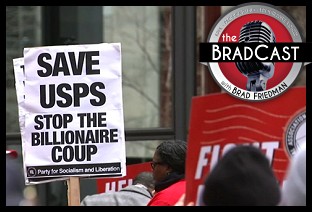 Postal Workers Union Prez: USPS 'Belongs to the People, Not the Billionaires':
Postal Workers Union Prez: USPS 'Belongs to the People, Not the Billionaires':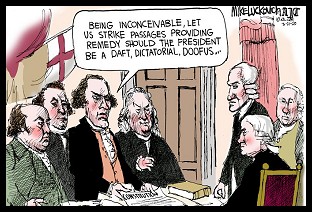 Sunday 'Suddenly Conceivable' Toons
Sunday 'Suddenly Conceivable' Toons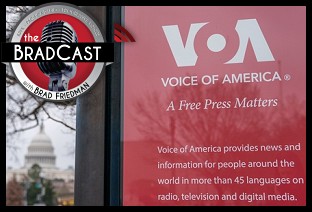 We're ALL Voice of America Now: 'BradCast' 3/20/25
We're ALL Voice of America Now: 'BradCast' 3/20/25 'Green News Report' 3/20/25
'Green News Report' 3/20/25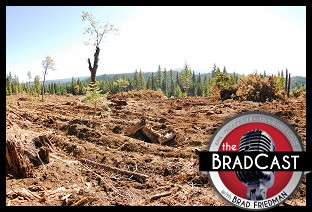 What Trump's 'Timber Production Expansion' Means (and Costs): 'BradCast' 3/19/25
What Trump's 'Timber Production Expansion' Means (and Costs): 'BradCast' 3/19/25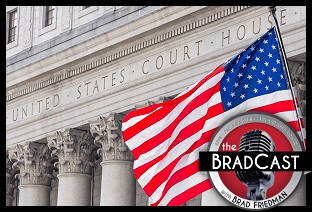 Courts Largely Holding Against Trump, Musk Lawlessness: 'BradCast' 3/18/25
Courts Largely Holding Against Trump, Musk Lawlessness: 'BradCast' 3/18/25 'Green News Report' 3/18/25
'Green News Report' 3/18/25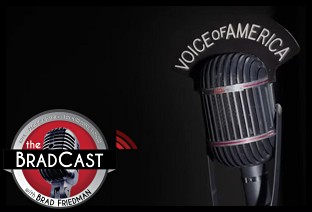 Chief VOA Reporter on Outlet Falling Silent First Time Since 1942: 'BradCast' 3/17/25
Chief VOA Reporter on Outlet Falling Silent First Time Since 1942: 'BradCast' 3/17/25 Sunday 'The Usual' Toons
Sunday 'The Usual' Toons 'Green News Report' 3/13/25
'Green News Report' 3/13/25 Trump EPA Unveils Plans to Endanger, Sicken Americans: 'BradCast' 3/13/25
Trump EPA Unveils Plans to Endanger, Sicken Americans: 'BradCast' 3/13/25 Trump Nixed Enforce-ment Against 100 Corp. Lawbreakers: 'BradCast' 3/12/25
Trump Nixed Enforce-ment Against 100 Corp. Lawbreakers: 'BradCast' 3/12/25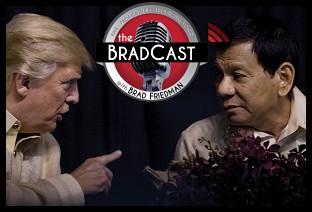 Bad Day for 'Strongmen': 'BradCast' 3/11
Bad Day for 'Strongmen': 'BradCast' 3/11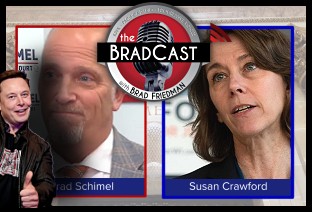 WI Election Could Flip Supreme Court Control, Musk Jumps In: 'BradCast' 3/10
WI Election Could Flip Supreme Court Control, Musk Jumps In: 'BradCast' 3/10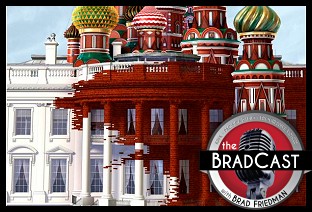 'What Else Could a Russian Asset Do That Trump Hasn't?': 'BradCast' 3/6/25
'What Else Could a Russian Asset Do That Trump Hasn't?': 'BradCast' 3/6/25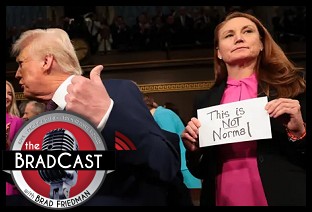 The Longest, Dullest, Most Lie-Filled 'SOTU' Ever: 'BradCast' 3/5/25
The Longest, Dullest, Most Lie-Filled 'SOTU' Ever: 'BradCast' 3/5/25 Trump Bad for Biz... and Farmers... and Nat'l Parks... and...: 'BradCast' 3/4/25
Trump Bad for Biz... and Farmers... and Nat'l Parks... and...: 'BradCast' 3/4/25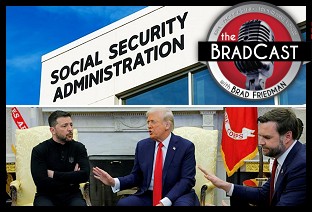 Trump Targeting 50% Cuts, Office Closures at Social Security: 'BradCast' 3/3/25
Trump Targeting 50% Cuts, Office Closures at Social Security: 'BradCast' 3/3/25
![Click to show/hide [+]](https://bradblog.com/images/toggle_plus.gif)
 VA GOP VOTER REG FRAUDSTER OFF HOOK
VA GOP VOTER REG FRAUDSTER OFF HOOK Criminal GOP Voter Registration Fraud Probe Expanding in VA
Criminal GOP Voter Registration Fraud Probe Expanding in VA DOJ PROBE SOUGHT AFTER VA ARREST
DOJ PROBE SOUGHT AFTER VA ARREST Arrest in VA: GOP Voter Reg Scandal Widens
Arrest in VA: GOP Voter Reg Scandal Widens ALL TOGETHER: ROVE, SPROUL, KOCHS, RNC
ALL TOGETHER: ROVE, SPROUL, KOCHS, RNC LATimes: RNC's 'Fired' Sproul Working for Repubs in 'as Many as 30 States'
LATimes: RNC's 'Fired' Sproul Working for Repubs in 'as Many as 30 States' 'Fired' Sproul Group 'Cloned', Still Working for Republicans in At Least 10 States
'Fired' Sproul Group 'Cloned', Still Working for Republicans in At Least 10 States FINALLY: FOX ON GOP REG FRAUD SCANDAL
FINALLY: FOX ON GOP REG FRAUD SCANDAL COLORADO FOLLOWS FLORIDA WITH GOP CRIMINAL INVESTIGATION
COLORADO FOLLOWS FLORIDA WITH GOP CRIMINAL INVESTIGATION CRIMINAL PROBE LAUNCHED INTO GOP VOTER REGISTRATION FRAUD SCANDAL IN FL
CRIMINAL PROBE LAUNCHED INTO GOP VOTER REGISTRATION FRAUD SCANDAL IN FL Brad Breaks PA Photo ID & GOP Registration Fraud Scandal News on Hartmann TV
Brad Breaks PA Photo ID & GOP Registration Fraud Scandal News on Hartmann TV  CAUGHT ON TAPE: COORDINATED NATIONWIDE GOP VOTER REG SCAM
CAUGHT ON TAPE: COORDINATED NATIONWIDE GOP VOTER REG SCAM CRIMINAL ELECTION FRAUD COMPLAINT FILED AGAINST GOP 'FRAUD' FIRM
CRIMINAL ELECTION FRAUD COMPLAINT FILED AGAINST GOP 'FRAUD' FIRM RICK SCOTT GETS ROLLED IN GOP REGISTRATION FRAUD SCANDAL
RICK SCOTT GETS ROLLED IN GOP REGISTRATION FRAUD SCANDAL VIDEO: Brad Breaks GOP Reg Fraud Scandal on Hartmann TV
VIDEO: Brad Breaks GOP Reg Fraud Scandal on Hartmann TV RNC FIRES NATIONAL VOTER REGISTRATION FIRM FOR FRAUD
RNC FIRES NATIONAL VOTER REGISTRATION FIRM FOR FRAUD EXCLUSIVE: Intvw w/ FL Official Who First Discovered GOP Reg Fraud
EXCLUSIVE: Intvw w/ FL Official Who First Discovered GOP Reg Fraud GOP REGISTRATION FRAUD FOUND IN FL
GOP REGISTRATION FRAUD FOUND IN FL



































